Hofstede’s Cultural Dimensions and their Impact on Business Growth: A Comparison between Australia and China
VerifiedAdded on 2023/06/17
|8
|2467
|57
AI Summary
This report discusses Hofstede’s Cultural Dimensions theory and its application to business growth in Australia and China. It covers six major dimensions, including individualism vs collectivism, power distance, masculinity vs femininity, uncertainty avoidance, long term vs short term orientation, and indulgence vs restraint. The report concludes that cross-cultural dimensions are essential for a deep understanding of national culture and systematic growth.
Contribute Materials
Your contribution can guide someone’s learning journey. Share your
documents today.
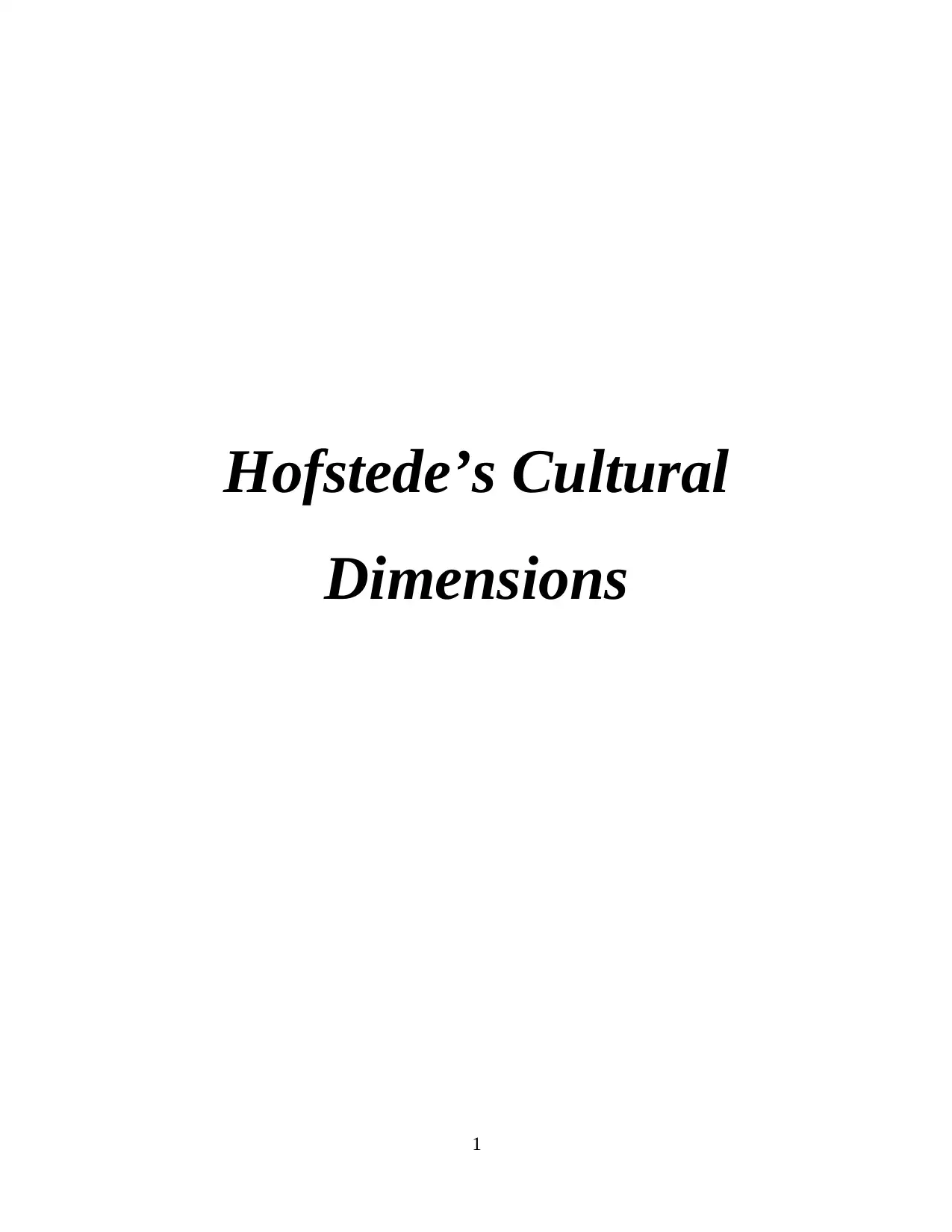
Hofstede’s Cultural
Dimensions
1
Dimensions
1
Secure Best Marks with AI Grader
Need help grading? Try our AI Grader for instant feedback on your assignments.
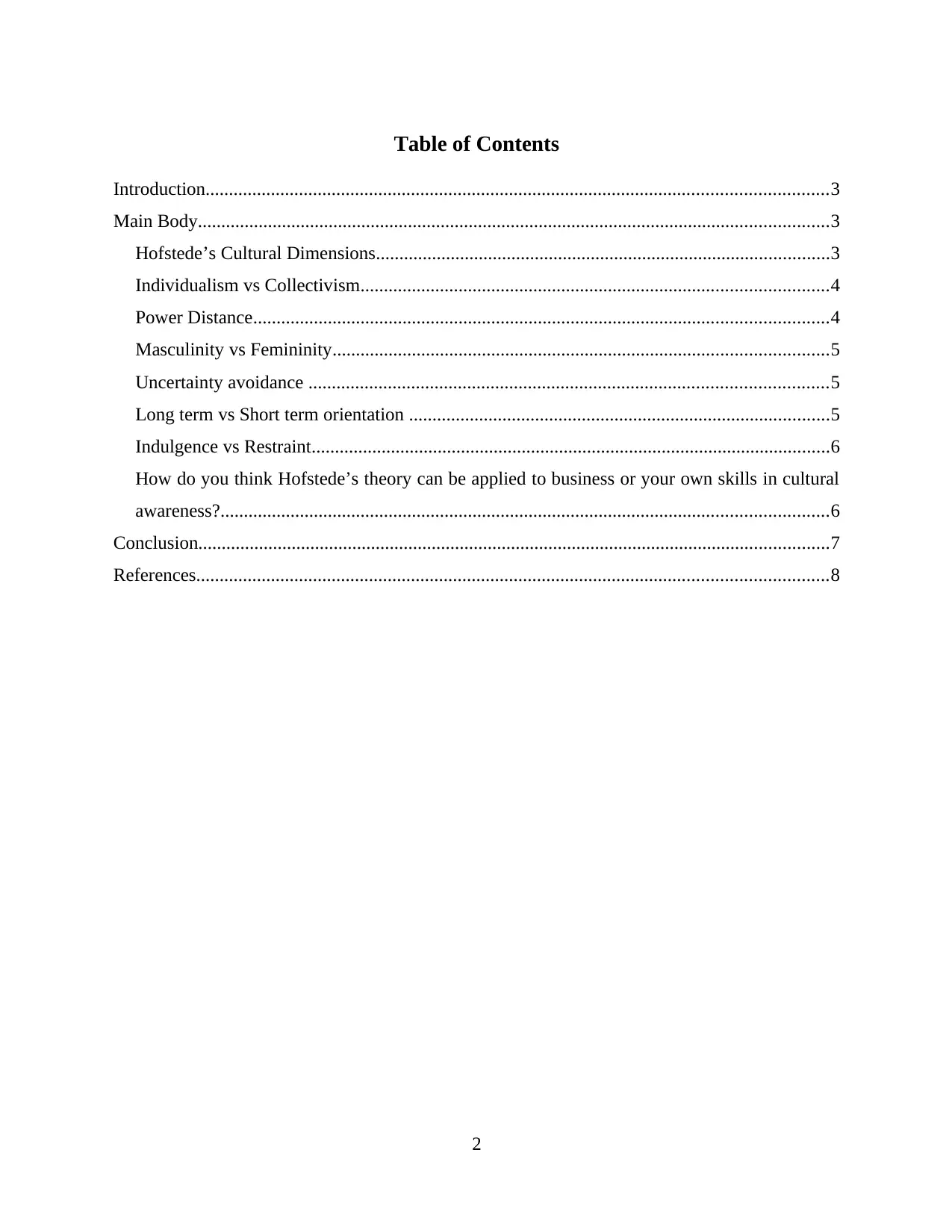
Table of Contents
Introduction.....................................................................................................................................3
Main Body.......................................................................................................................................3
Hofstede’s Cultural Dimensions.................................................................................................3
Individualism vs Collectivism....................................................................................................4
Power Distance...........................................................................................................................4
Masculinity vs Femininity..........................................................................................................5
Uncertainty avoidance ...............................................................................................................5
Long term vs Short term orientation ..........................................................................................5
Indulgence vs Restraint...............................................................................................................6
How do you think Hofstede’s theory can be applied to business or your own skills in cultural
awareness?..................................................................................................................................6
Conclusion.......................................................................................................................................7
References.......................................................................................................................................8
2
Introduction.....................................................................................................................................3
Main Body.......................................................................................................................................3
Hofstede’s Cultural Dimensions.................................................................................................3
Individualism vs Collectivism....................................................................................................4
Power Distance...........................................................................................................................4
Masculinity vs Femininity..........................................................................................................5
Uncertainty avoidance ...............................................................................................................5
Long term vs Short term orientation ..........................................................................................5
Indulgence vs Restraint...............................................................................................................6
How do you think Hofstede’s theory can be applied to business or your own skills in cultural
awareness?..................................................................................................................................6
Conclusion.......................................................................................................................................7
References.......................................................................................................................................8
2
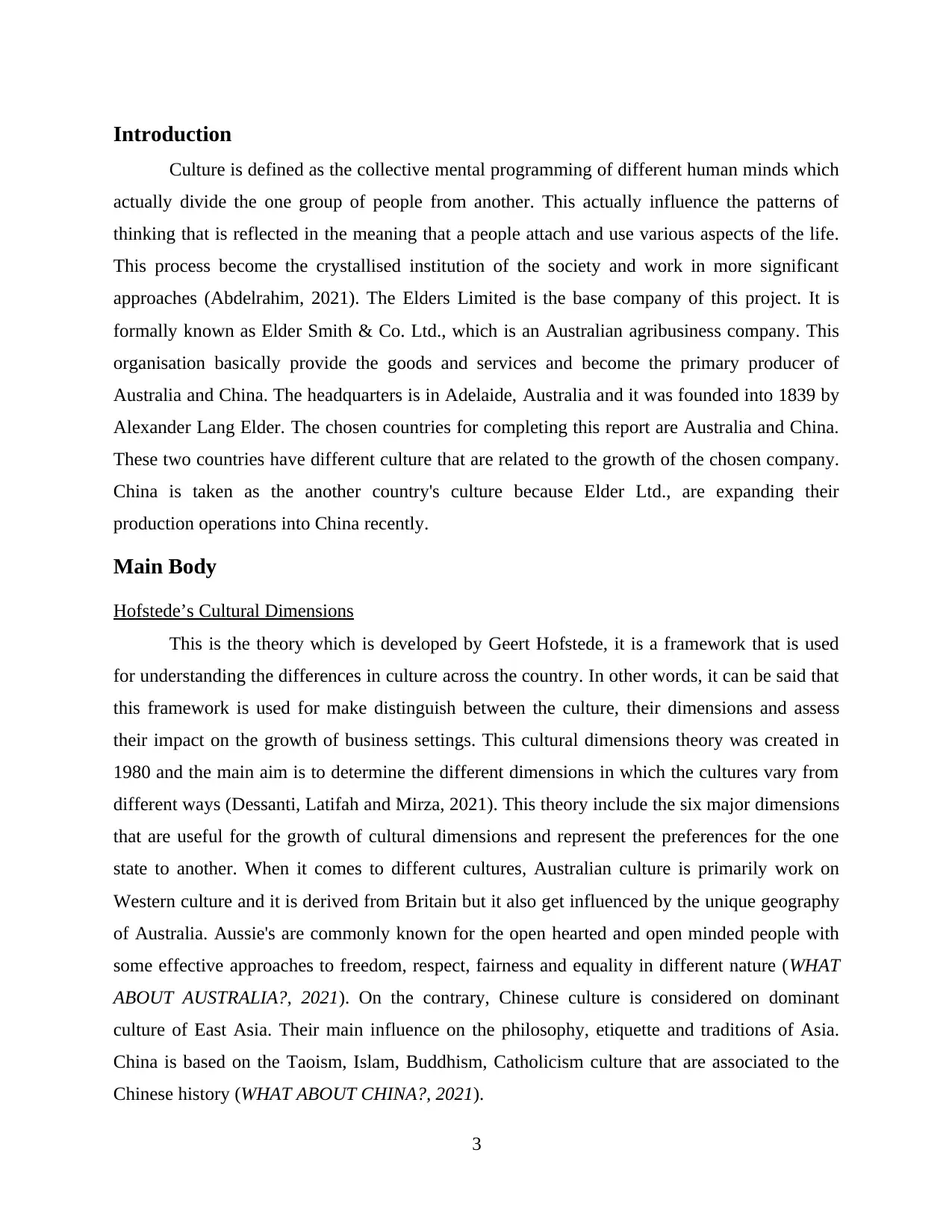
Introduction
Culture is defined as the collective mental programming of different human minds which
actually divide the one group of people from another. This actually influence the patterns of
thinking that is reflected in the meaning that a people attach and use various aspects of the life.
This process become the crystallised institution of the society and work in more significant
approaches (Abdelrahim, 2021). The Elders Limited is the base company of this project. It is
formally known as Elder Smith & Co. Ltd., which is an Australian agribusiness company. This
organisation basically provide the goods and services and become the primary producer of
Australia and China. The headquarters is in Adelaide, Australia and it was founded into 1839 by
Alexander Lang Elder. The chosen countries for completing this report are Australia and China.
These two countries have different culture that are related to the growth of the chosen company.
China is taken as the another country's culture because Elder Ltd., are expanding their
production operations into China recently.
Main Body
Hofstede’s Cultural Dimensions
This is the theory which is developed by Geert Hofstede, it is a framework that is used
for understanding the differences in culture across the country. In other words, it can be said that
this framework is used for make distinguish between the culture, their dimensions and assess
their impact on the growth of business settings. This cultural dimensions theory was created in
1980 and the main aim is to determine the different dimensions in which the cultures vary from
different ways (Dessanti, Latifah and Mirza, 2021). This theory include the six major dimensions
that are useful for the growth of cultural dimensions and represent the preferences for the one
state to another. When it comes to different cultures, Australian culture is primarily work on
Western culture and it is derived from Britain but it also get influenced by the unique geography
of Australia. Aussie's are commonly known for the open hearted and open minded people with
some effective approaches to freedom, respect, fairness and equality in different nature (WHAT
ABOUT AUSTRALIA?, 2021). On the contrary, Chinese culture is considered on dominant
culture of East Asia. Their main influence on the philosophy, etiquette and traditions of Asia.
China is based on the Taoism, Islam, Buddhism, Catholicism culture that are associated to the
Chinese history (WHAT ABOUT CHINA?, 2021).
3
Culture is defined as the collective mental programming of different human minds which
actually divide the one group of people from another. This actually influence the patterns of
thinking that is reflected in the meaning that a people attach and use various aspects of the life.
This process become the crystallised institution of the society and work in more significant
approaches (Abdelrahim, 2021). The Elders Limited is the base company of this project. It is
formally known as Elder Smith & Co. Ltd., which is an Australian agribusiness company. This
organisation basically provide the goods and services and become the primary producer of
Australia and China. The headquarters is in Adelaide, Australia and it was founded into 1839 by
Alexander Lang Elder. The chosen countries for completing this report are Australia and China.
These two countries have different culture that are related to the growth of the chosen company.
China is taken as the another country's culture because Elder Ltd., are expanding their
production operations into China recently.
Main Body
Hofstede’s Cultural Dimensions
This is the theory which is developed by Geert Hofstede, it is a framework that is used
for understanding the differences in culture across the country. In other words, it can be said that
this framework is used for make distinguish between the culture, their dimensions and assess
their impact on the growth of business settings. This cultural dimensions theory was created in
1980 and the main aim is to determine the different dimensions in which the cultures vary from
different ways (Dessanti, Latifah and Mirza, 2021). This theory include the six major dimensions
that are useful for the growth of cultural dimensions and represent the preferences for the one
state to another. When it comes to different cultures, Australian culture is primarily work on
Western culture and it is derived from Britain but it also get influenced by the unique geography
of Australia. Aussie's are commonly known for the open hearted and open minded people with
some effective approaches to freedom, respect, fairness and equality in different nature (WHAT
ABOUT AUSTRALIA?, 2021). On the contrary, Chinese culture is considered on dominant
culture of East Asia. Their main influence on the philosophy, etiquette and traditions of Asia.
China is based on the Taoism, Islam, Buddhism, Catholicism culture that are associated to the
Chinese history (WHAT ABOUT CHINA?, 2021).
3
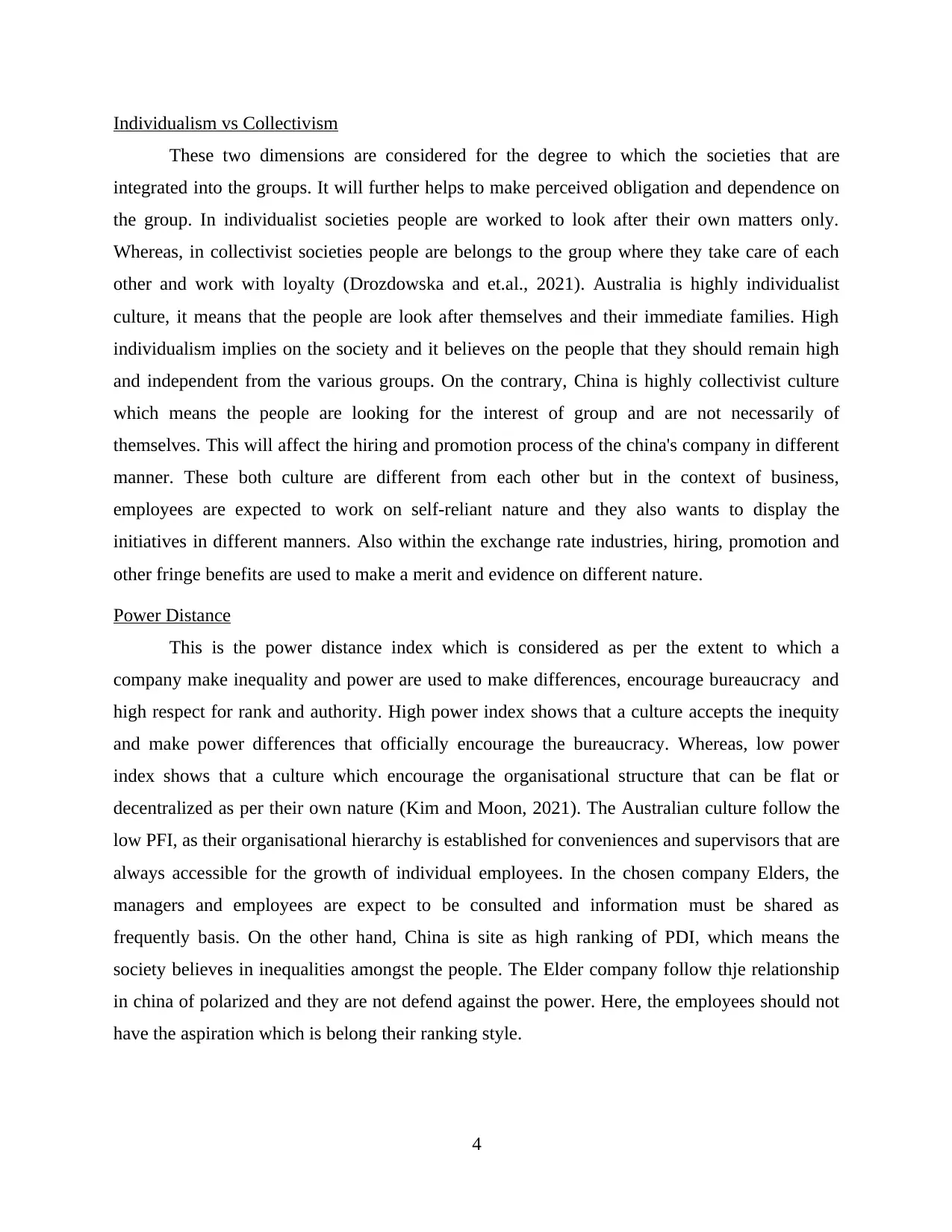
Individualism vs Collectivism
These two dimensions are considered for the degree to which the societies that are
integrated into the groups. It will further helps to make perceived obligation and dependence on
the group. In individualist societies people are worked to look after their own matters only.
Whereas, in collectivist societies people are belongs to the group where they take care of each
other and work with loyalty (Drozdowska and et.al., 2021). Australia is highly individualist
culture, it means that the people are look after themselves and their immediate families. High
individualism implies on the society and it believes on the people that they should remain high
and independent from the various groups. On the contrary, China is highly collectivist culture
which means the people are looking for the interest of group and are not necessarily of
themselves. This will affect the hiring and promotion process of the china's company in different
manner. These both culture are different from each other but in the context of business,
employees are expected to work on self-reliant nature and they also wants to display the
initiatives in different manners. Also within the exchange rate industries, hiring, promotion and
other fringe benefits are used to make a merit and evidence on different nature.
Power Distance
This is the power distance index which is considered as per the extent to which a
company make inequality and power are used to make differences, encourage bureaucracy and
high respect for rank and authority. High power index shows that a culture accepts the inequity
and make power differences that officially encourage the bureaucracy. Whereas, low power
index shows that a culture which encourage the organisational structure that can be flat or
decentralized as per their own nature (Kim and Moon, 2021). The Australian culture follow the
low PFI, as their organisational hierarchy is established for conveniences and supervisors that are
always accessible for the growth of individual employees. In the chosen company Elders, the
managers and employees are expect to be consulted and information must be shared as
frequently basis. On the other hand, China is site as high ranking of PDI, which means the
society believes in inequalities amongst the people. The Elder company follow thje relationship
in china of polarized and they are not defend against the power. Here, the employees should not
have the aspiration which is belong their ranking style.
4
These two dimensions are considered for the degree to which the societies that are
integrated into the groups. It will further helps to make perceived obligation and dependence on
the group. In individualist societies people are worked to look after their own matters only.
Whereas, in collectivist societies people are belongs to the group where they take care of each
other and work with loyalty (Drozdowska and et.al., 2021). Australia is highly individualist
culture, it means that the people are look after themselves and their immediate families. High
individualism implies on the society and it believes on the people that they should remain high
and independent from the various groups. On the contrary, China is highly collectivist culture
which means the people are looking for the interest of group and are not necessarily of
themselves. This will affect the hiring and promotion process of the china's company in different
manner. These both culture are different from each other but in the context of business,
employees are expected to work on self-reliant nature and they also wants to display the
initiatives in different manners. Also within the exchange rate industries, hiring, promotion and
other fringe benefits are used to make a merit and evidence on different nature.
Power Distance
This is the power distance index which is considered as per the extent to which a
company make inequality and power are used to make differences, encourage bureaucracy and
high respect for rank and authority. High power index shows that a culture accepts the inequity
and make power differences that officially encourage the bureaucracy. Whereas, low power
index shows that a culture which encourage the organisational structure that can be flat or
decentralized as per their own nature (Kim and Moon, 2021). The Australian culture follow the
low PFI, as their organisational hierarchy is established for conveniences and supervisors that are
always accessible for the growth of individual employees. In the chosen company Elders, the
managers and employees are expect to be consulted and information must be shared as
frequently basis. On the other hand, China is site as high ranking of PDI, which means the
society believes in inequalities amongst the people. The Elder company follow thje relationship
in china of polarized and they are not defend against the power. Here, the employees should not
have the aspiration which is belong their ranking style.
4
Secure Best Marks with AI Grader
Need help grading? Try our AI Grader for instant feedback on your assignments.
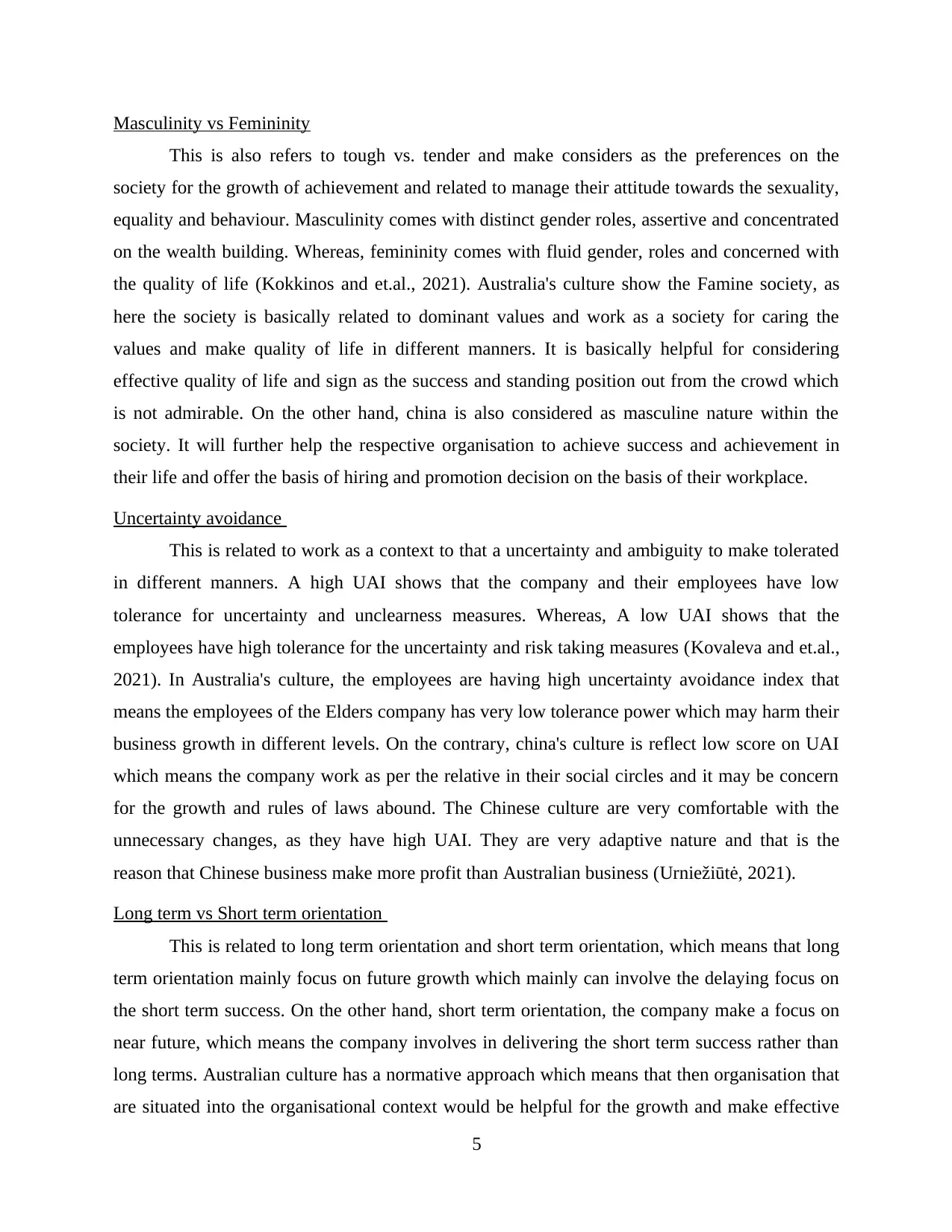
Masculinity vs Femininity
This is also refers to tough vs. tender and make considers as the preferences on the
society for the growth of achievement and related to manage their attitude towards the sexuality,
equality and behaviour. Masculinity comes with distinct gender roles, assertive and concentrated
on the wealth building. Whereas, femininity comes with fluid gender, roles and concerned with
the quality of life (Kokkinos and et.al., 2021). Australia's culture show the Famine society, as
here the society is basically related to dominant values and work as a society for caring the
values and make quality of life in different manners. It is basically helpful for considering
effective quality of life and sign as the success and standing position out from the crowd which
is not admirable. On the other hand, china is also considered as masculine nature within the
society. It will further help the respective organisation to achieve success and achievement in
their life and offer the basis of hiring and promotion decision on the basis of their workplace.
Uncertainty avoidance
This is related to work as a context to that a uncertainty and ambiguity to make tolerated
in different manners. A high UAI shows that the company and their employees have low
tolerance for uncertainty and unclearness measures. Whereas, A low UAI shows that the
employees have high tolerance for the uncertainty and risk taking measures (Kovaleva and et.al.,
2021). In Australia's culture, the employees are having high uncertainty avoidance index that
means the employees of the Elders company has very low tolerance power which may harm their
business growth in different levels. On the contrary, china's culture is reflect low score on UAI
which means the company work as per the relative in their social circles and it may be concern
for the growth and rules of laws abound. The Chinese culture are very comfortable with the
unnecessary changes, as they have high UAI. They are very adaptive nature and that is the
reason that Chinese business make more profit than Australian business (Urniežiūtė, 2021).
Long term vs Short term orientation
This is related to long term orientation and short term orientation, which means that long
term orientation mainly focus on future growth which mainly can involve the delaying focus on
the short term success. On the other hand, short term orientation, the company make a focus on
near future, which means the company involves in delivering the short term success rather than
long terms. Australian culture has a normative approach which means that then organisation that
are situated into the organisational context would be helpful for the growth and make effective
5
This is also refers to tough vs. tender and make considers as the preferences on the
society for the growth of achievement and related to manage their attitude towards the sexuality,
equality and behaviour. Masculinity comes with distinct gender roles, assertive and concentrated
on the wealth building. Whereas, femininity comes with fluid gender, roles and concerned with
the quality of life (Kokkinos and et.al., 2021). Australia's culture show the Famine society, as
here the society is basically related to dominant values and work as a society for caring the
values and make quality of life in different manners. It is basically helpful for considering
effective quality of life and sign as the success and standing position out from the crowd which
is not admirable. On the other hand, china is also considered as masculine nature within the
society. It will further help the respective organisation to achieve success and achievement in
their life and offer the basis of hiring and promotion decision on the basis of their workplace.
Uncertainty avoidance
This is related to work as a context to that a uncertainty and ambiguity to make tolerated
in different manners. A high UAI shows that the company and their employees have low
tolerance for uncertainty and unclearness measures. Whereas, A low UAI shows that the
employees have high tolerance for the uncertainty and risk taking measures (Kovaleva and et.al.,
2021). In Australia's culture, the employees are having high uncertainty avoidance index that
means the employees of the Elders company has very low tolerance power which may harm their
business growth in different levels. On the contrary, china's culture is reflect low score on UAI
which means the company work as per the relative in their social circles and it may be concern
for the growth and rules of laws abound. The Chinese culture are very comfortable with the
unnecessary changes, as they have high UAI. They are very adaptive nature and that is the
reason that Chinese business make more profit than Australian business (Urniežiūtė, 2021).
Long term vs Short term orientation
This is related to long term orientation and short term orientation, which means that long
term orientation mainly focus on future growth which mainly can involve the delaying focus on
the short term success. On the other hand, short term orientation, the company make a focus on
near future, which means the company involves in delivering the short term success rather than
long terms. Australian culture has a normative approach which means that then organisation that
are situated into the organisational context would be helpful for the growth and make effective
5
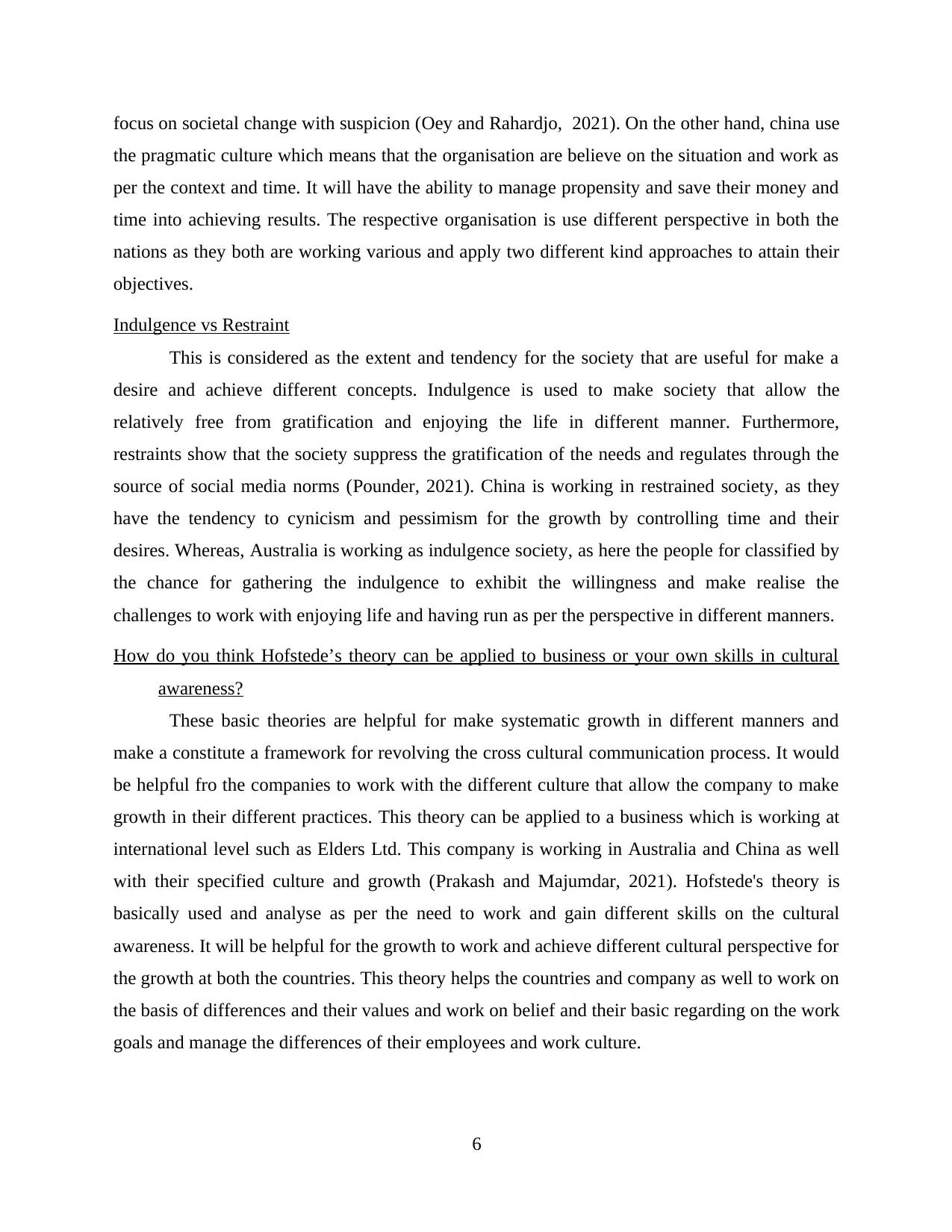
focus on societal change with suspicion (Oey and Rahardjo, 2021). On the other hand, china use
the pragmatic culture which means that the organisation are believe on the situation and work as
per the context and time. It will have the ability to manage propensity and save their money and
time into achieving results. The respective organisation is use different perspective in both the
nations as they both are working various and apply two different kind approaches to attain their
objectives.
Indulgence vs Restraint
This is considered as the extent and tendency for the society that are useful for make a
desire and achieve different concepts. Indulgence is used to make society that allow the
relatively free from gratification and enjoying the life in different manner. Furthermore,
restraints show that the society suppress the gratification of the needs and regulates through the
source of social media norms (Pounder, 2021). China is working in restrained society, as they
have the tendency to cynicism and pessimism for the growth by controlling time and their
desires. Whereas, Australia is working as indulgence society, as here the people for classified by
the chance for gathering the indulgence to exhibit the willingness and make realise the
challenges to work with enjoying life and having run as per the perspective in different manners.
How do you think Hofstede’s theory can be applied to business or your own skills in cultural
awareness?
These basic theories are helpful for make systematic growth in different manners and
make a constitute a framework for revolving the cross cultural communication process. It would
be helpful fro the companies to work with the different culture that allow the company to make
growth in their different practices. This theory can be applied to a business which is working at
international level such as Elders Ltd. This company is working in Australia and China as well
with their specified culture and growth (Prakash and Majumdar, 2021). Hofstede's theory is
basically used and analyse as per the need to work and gain different skills on the cultural
awareness. It will be helpful for the growth to work and achieve different cultural perspective for
the growth at both the countries. This theory helps the countries and company as well to work on
the basis of differences and their values and work on belief and their basic regarding on the work
goals and manage the differences of their employees and work culture.
6
the pragmatic culture which means that the organisation are believe on the situation and work as
per the context and time. It will have the ability to manage propensity and save their money and
time into achieving results. The respective organisation is use different perspective in both the
nations as they both are working various and apply two different kind approaches to attain their
objectives.
Indulgence vs Restraint
This is considered as the extent and tendency for the society that are useful for make a
desire and achieve different concepts. Indulgence is used to make society that allow the
relatively free from gratification and enjoying the life in different manner. Furthermore,
restraints show that the society suppress the gratification of the needs and regulates through the
source of social media norms (Pounder, 2021). China is working in restrained society, as they
have the tendency to cynicism and pessimism for the growth by controlling time and their
desires. Whereas, Australia is working as indulgence society, as here the people for classified by
the chance for gathering the indulgence to exhibit the willingness and make realise the
challenges to work with enjoying life and having run as per the perspective in different manners.
How do you think Hofstede’s theory can be applied to business or your own skills in cultural
awareness?
These basic theories are helpful for make systematic growth in different manners and
make a constitute a framework for revolving the cross cultural communication process. It would
be helpful fro the companies to work with the different culture that allow the company to make
growth in their different practices. This theory can be applied to a business which is working at
international level such as Elders Ltd. This company is working in Australia and China as well
with their specified culture and growth (Prakash and Majumdar, 2021). Hofstede's theory is
basically used and analyse as per the need to work and gain different skills on the cultural
awareness. It will be helpful for the growth to work and achieve different cultural perspective for
the growth at both the countries. This theory helps the countries and company as well to work on
the basis of differences and their values and work on belief and their basic regarding on the work
goals and manage the differences of their employees and work culture.
6
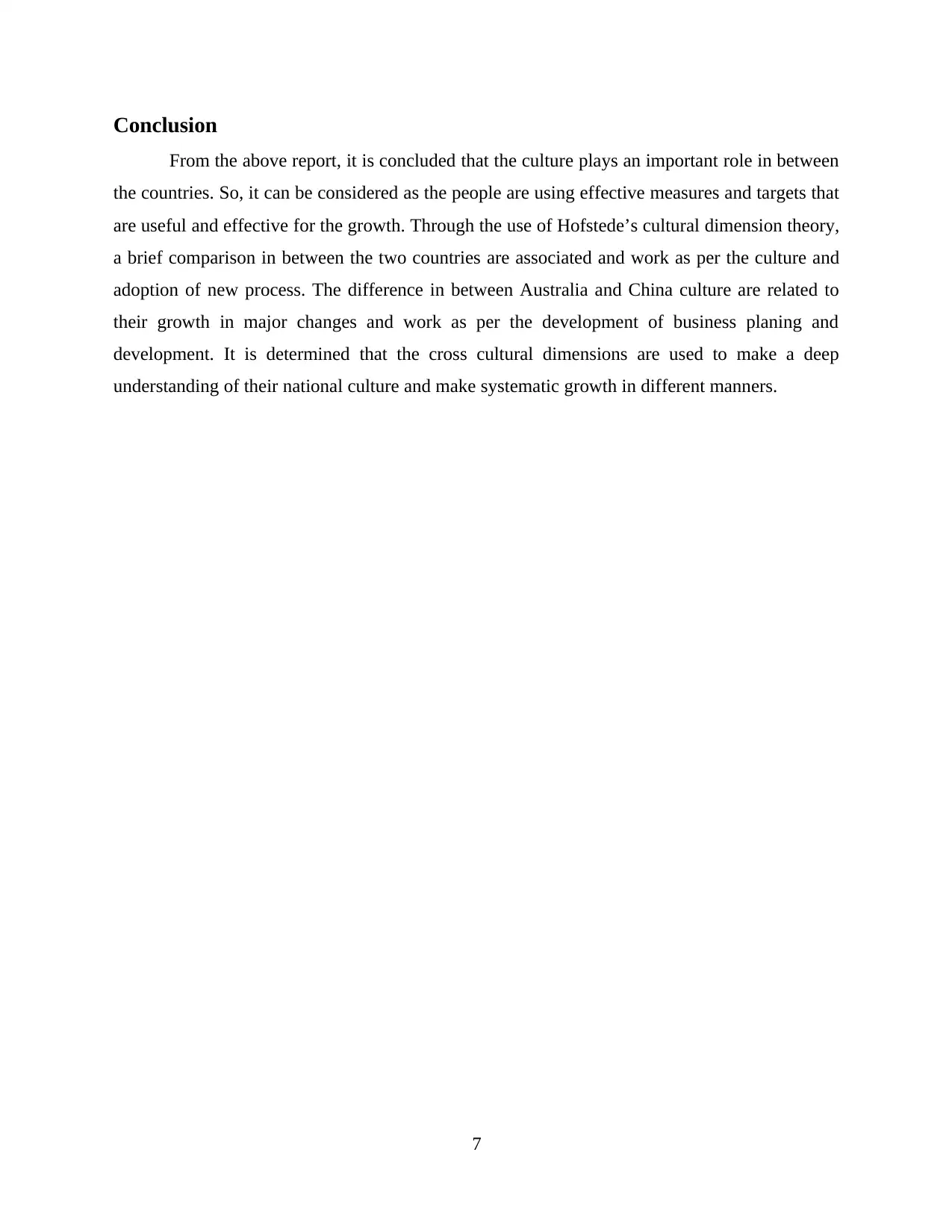
Conclusion
From the above report, it is concluded that the culture plays an important role in between
the countries. So, it can be considered as the people are using effective measures and targets that
are useful and effective for the growth. Through the use of Hofstede’s cultural dimension theory,
a brief comparison in between the two countries are associated and work as per the culture and
adoption of new process. The difference in between Australia and China culture are related to
their growth in major changes and work as per the development of business planing and
development. It is determined that the cross cultural dimensions are used to make a deep
understanding of their national culture and make systematic growth in different manners.
7
From the above report, it is concluded that the culture plays an important role in between
the countries. So, it can be considered as the people are using effective measures and targets that
are useful and effective for the growth. Through the use of Hofstede’s cultural dimension theory,
a brief comparison in between the two countries are associated and work as per the culture and
adoption of new process. The difference in between Australia and China culture are related to
their growth in major changes and work as per the development of business planing and
development. It is determined that the cross cultural dimensions are used to make a deep
understanding of their national culture and make systematic growth in different manners.
7
Paraphrase This Document
Need a fresh take? Get an instant paraphrase of this document with our AI Paraphraser
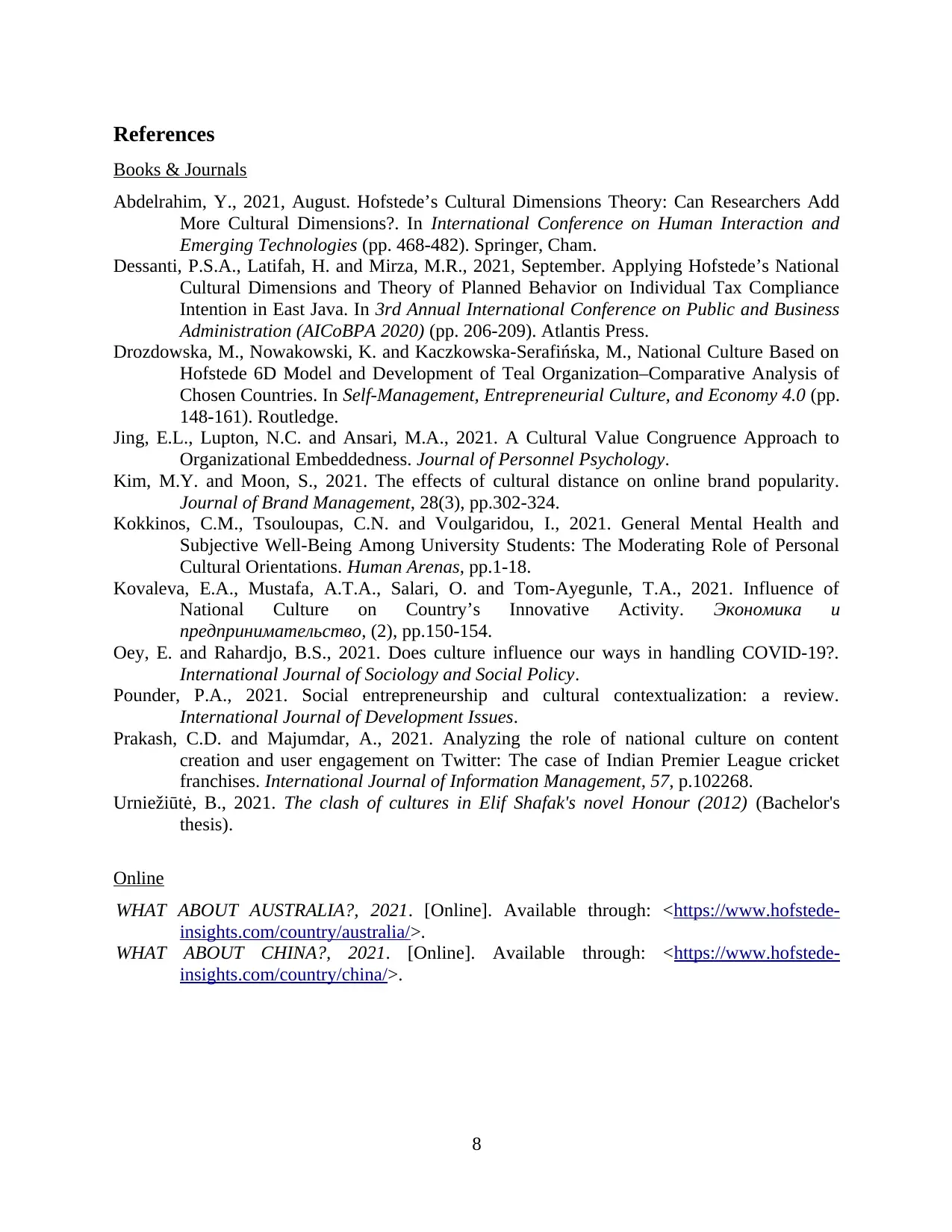
References
Books & Journals
Abdelrahim, Y., 2021, August. Hofstede’s Cultural Dimensions Theory: Can Researchers Add
More Cultural Dimensions?. In International Conference on Human Interaction and
Emerging Technologies (pp. 468-482). Springer, Cham.
Dessanti, P.S.A., Latifah, H. and Mirza, M.R., 2021, September. Applying Hofstede’s National
Cultural Dimensions and Theory of Planned Behavior on Individual Tax Compliance
Intention in East Java. In 3rd Annual International Conference on Public and Business
Administration (AICoBPA 2020) (pp. 206-209). Atlantis Press.
Drozdowska, M., Nowakowski, K. and Kaczkowska-Serafińska, M., National Culture Based on
Hofstede 6D Model and Development of Teal Organization–Comparative Analysis of
Chosen Countries. In Self-Management, Entrepreneurial Culture, and Economy 4.0 (pp.
148-161). Routledge.
Jing, E.L., Lupton, N.C. and Ansari, M.A., 2021. A Cultural Value Congruence Approach to
Organizational Embeddedness. Journal of Personnel Psychology.
Kim, M.Y. and Moon, S., 2021. The effects of cultural distance on online brand popularity.
Journal of Brand Management, 28(3), pp.302-324.
Kokkinos, C.M., Tsouloupas, C.N. and Voulgaridou, I., 2021. General Mental Health and
Subjective Well-Being Among University Students: The Moderating Role of Personal
Cultural Orientations. Human Arenas, pp.1-18.
Kovaleva, E.A., Mustafa, A.T.A., Salari, O. and Tom-Ayegunle, T.A., 2021. Influence of
National Culture on Country’s Innovative Activity. Экономика и
предпринимательство, (2), pp.150-154.
Oey, E. and Rahardjo, B.S., 2021. Does culture influence our ways in handling COVID-19?.
International Journal of Sociology and Social Policy.
Pounder, P.A., 2021. Social entrepreneurship and cultural contextualization: a review.
International Journal of Development Issues.
Prakash, C.D. and Majumdar, A., 2021. Analyzing the role of national culture on content
creation and user engagement on Twitter: The case of Indian Premier League cricket
franchises. International Journal of Information Management, 57, p.102268.
Urniežiūtė, B., 2021. The clash of cultures in Elif Shafak's novel Honour (2012) (Bachelor's
thesis).
Online
WHAT ABOUT AUSTRALIA?, 2021. [Online]. Available through: <https://www.hofstede-
insights.com/country/australia/>.
WHAT ABOUT CHINA?, 2021. [Online]. Available through: <https://www.hofstede-
insights.com/country/china/>.
8
Books & Journals
Abdelrahim, Y., 2021, August. Hofstede’s Cultural Dimensions Theory: Can Researchers Add
More Cultural Dimensions?. In International Conference on Human Interaction and
Emerging Technologies (pp. 468-482). Springer, Cham.
Dessanti, P.S.A., Latifah, H. and Mirza, M.R., 2021, September. Applying Hofstede’s National
Cultural Dimensions and Theory of Planned Behavior on Individual Tax Compliance
Intention in East Java. In 3rd Annual International Conference on Public and Business
Administration (AICoBPA 2020) (pp. 206-209). Atlantis Press.
Drozdowska, M., Nowakowski, K. and Kaczkowska-Serafińska, M., National Culture Based on
Hofstede 6D Model and Development of Teal Organization–Comparative Analysis of
Chosen Countries. In Self-Management, Entrepreneurial Culture, and Economy 4.0 (pp.
148-161). Routledge.
Jing, E.L., Lupton, N.C. and Ansari, M.A., 2021. A Cultural Value Congruence Approach to
Organizational Embeddedness. Journal of Personnel Psychology.
Kim, M.Y. and Moon, S., 2021. The effects of cultural distance on online brand popularity.
Journal of Brand Management, 28(3), pp.302-324.
Kokkinos, C.M., Tsouloupas, C.N. and Voulgaridou, I., 2021. General Mental Health and
Subjective Well-Being Among University Students: The Moderating Role of Personal
Cultural Orientations. Human Arenas, pp.1-18.
Kovaleva, E.A., Mustafa, A.T.A., Salari, O. and Tom-Ayegunle, T.A., 2021. Influence of
National Culture on Country’s Innovative Activity. Экономика и
предпринимательство, (2), pp.150-154.
Oey, E. and Rahardjo, B.S., 2021. Does culture influence our ways in handling COVID-19?.
International Journal of Sociology and Social Policy.
Pounder, P.A., 2021. Social entrepreneurship and cultural contextualization: a review.
International Journal of Development Issues.
Prakash, C.D. and Majumdar, A., 2021. Analyzing the role of national culture on content
creation and user engagement on Twitter: The case of Indian Premier League cricket
franchises. International Journal of Information Management, 57, p.102268.
Urniežiūtė, B., 2021. The clash of cultures in Elif Shafak's novel Honour (2012) (Bachelor's
thesis).
Online
WHAT ABOUT AUSTRALIA?, 2021. [Online]. Available through: <https://www.hofstede-
insights.com/country/australia/>.
WHAT ABOUT CHINA?, 2021. [Online]. Available through: <https://www.hofstede-
insights.com/country/china/>.
8
1 out of 8
Related Documents
Your All-in-One AI-Powered Toolkit for Academic Success.
+13062052269
info@desklib.com
Available 24*7 on WhatsApp / Email
![[object Object]](/_next/static/media/star-bottom.7253800d.svg)
Unlock your academic potential
© 2024 | Zucol Services PVT LTD | All rights reserved.





